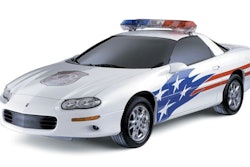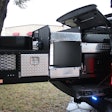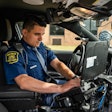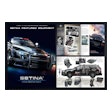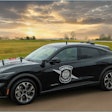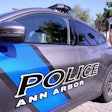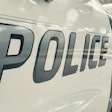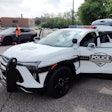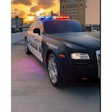I ease into the seat of the Crown Victoria patrol vehicle and reach for the key on the steering column when, at the intersection directly in front of me, a yellow Ford pickup blows through a stop sign and slams into a green Jeep Cherokee. The Jeep pulls over to the curb, but the pickup speeds away from the accident scene.
It looks to be a hit-and-run, and the way the Ford is being driven I have an under-the-influence driver too. I keep the pickup in view and shout to the Jeep driver to see if he's injured. He's OK.
On go my lights. As I begin the pursuit of the fleeing pickup, a Taurus coming through the next intersection fails to yield to the siren. Avoiding that idiot, I accelerate to catch the pickup. I put out the failure to yield on the radio and ask for cover only to find there is none. I ask for the department helicopter. It's grounded.
The pursuit is all mine now, and it's going to be a while before help comes my way. The pickup is coming to a heavily traveled boulevard. This time it goes through the red light and is almost struck by cross traffic. The driver makes the next left and I follow.
I get in behind him and with one hand on the mike and the other on the steering wheel, put the license plate out on the air. The suspect slams on the brakes. I drop the mike, steer and brake to avoid hitting the truck. If I hit him, my airbag will deploy, putting me out of service, and the pickup truck will probably sustain little damage.
At the next major intersection, the truck turns right, narrowly missing a school bus. I'm thinking this guy is really drunk or crazy, or maybe both. We accelerate down a long city street 50, 60, 70 miles per hour. My competitive juices are flowing and that natural tendency we have as cops is taking over. I'm not going to loose this guy, and I will put him in jail. He runs two more stop signs, and I just miss a white Honda Civic crossing the intersection oblivious to the emergency lights and siren.
By now, we are out in a residential area and the pickup accelerates past two school buses, blows another red light and makes the next left. I'm up over 70 mph now. I brake hard and make the left a few seconds behind the pickup only to be greeted by a dump truck and front-loader now blocking the roadway.
After the delay to clear around the construction equipment, the road ahead is empty. No cars. No pickup. Not a soul on the sidewalks to point the way. I shut down the emergency lights and siren, pull over, hit the steering wheel a few times and shout a few things that cannot be written here.
My heart rate is up, my breathing heavy, I'm perspiring, and I need to flush away the adrenaline that has been dumped into my system.
All of a sudden, the lights in the room come on and the sergeant in the instructor's uniform touches me on the shoulder and says, "OK, now. Let's take a look at this and see what we could have done better here."
Five other cops standing behind me start snickering. I know I blew it. I was unsafe, and if this had not been a simulation, I would have put the public that I have been sworn to serve in danger.
The playback of the pursuit shows in stark detail how I chased the computer-generated yellow Ford pickup through a well-marked school zone. There were school buses parked on the curb loading and off-loading kids. There were kids standing on the corner and some walking across the street in well-marked crosswalks. The only things the playback lacked were parents shaking their fists at me and filling out complaint-on-an-officer paperwork.
Decision-Based Training
The philosophy for driving simulation is similar to that of use-of-force simulators, which do not teach us how to shoot only the decision process on when to shoot. In a like manner, driving simulation doesn't teach us how to drive, it teaches us how to think while driving.
Driving skills are a combination of physical as well as mental processes. So much of driving is seat-of-the-pants. We feel a great deal of the process in G-Forces. You turn left and your body is forced to the right. You accelerate and are pushed back in the seat. It's basic physics. We have driven so much that we are able to feel when we are going too fast. We then make corrections until it feels right.
Therein lie the limitations of most driving simulators. Because most affordable driving simulators are stationary, there is only graphical input on which to base the feeling of G-Forces. The current fidelity level is about 80 percent of real driving. This makes basic, physical, driving instruction on simulators impractical.
Consequently, the real value of driving simulation is its capability to teach the student good decision-making skills. A simulator can put a driver in situations that in real life would be highly dangerous.
A case in point is the pursuit scenario detailed at the beginning of this article. It is designed to create a situation such as a minor, non-injury hit-and-run accident. The situation escalates as the pursuit develops and additional factors can be introduced such as drunken driving, an attempt to have the officer hit the suspect's vehicle, and cross-traffic disregarding the emergency lights and siren. Then, after the driver is sufficiently immersed and challenged in the situation, the pursuit goes into a school zone.
In review it becomes apparent how much a driver can miss once tunnel vision takes over. None of us would purposely endanger school children by pursuing a misdemeanor violator at high speed through a school zone. However, when the phenomenon is actually simulated, the learning experience is greatly enhanced and a tool is provided for overcoming tunnel vision in the future.
Intersection accident avoidance is another area that has shown marked improvement with simulator-based training. A number of years ago, the San Antonio (Texas) Police Department had a problem with officers being involved in intersection accidents. The department developed an aggressive training program involving on-track driving and simulation. The entire force completed the training, and intersection accidents declined by more than 51 percent.[PAGEBREAK]
In 1999, The California Commission on Peace Officer Standards and Training (POST) developed a statewide program called Perishable Skills Training. The program addresses firearms proficiency, defensive tactics and driving skills. POST mandated that every peace officer in California receive four hours of continuing training every two years in each of these identified perishable skills.
As part of the program, POST created 11 Regional Skills Centers, and there are plans to create at least three more. The centers were developed as part of existing police academies and serve all the law enforcement agencies within their regions.
POST provides funds to purchase use-of-force simulators, defensive tactics equipment and driving simulators. Each of the Regional Skills Centers must then develop its own curriculum, within POST guidelines, for a four-hour class.
Simulators
There are three major producers of driving simulators for police emergency vehicle operations. They are Doron, GE Capital I-SIM and FAAC.
Doron: Binghamton, New York-based Doron Precision Systems, Inc. has, by far, the largest installed base of driving simulators in the country.
Doron's Advanced Mobile Operations Simulator (AMOS) was originally based on an Atari video game. The company bought the software and developed it into a system for instruction.
The first AMOS units were very simple, and the graphics were crude by today's standards. But over the years, Doron has developed new software and applied new hardware technologies, and today it offers the AMOS II, which takes advantage of all these upgrades and offers an optional motion base.
Additionally, Doron introduced the 450LE model at the 2000 International Association of Chief's of Police convention. It features high-resolution visual imaging on three 42-inch, plasma, wide-screen displays that surround the driver with a continuous 190-degree field of view. The flat-screen, plasma technology also allows the 450LE to fit into limited training spaces.
GE Capital I-Sim: The core engineers at Salt Lake City-based GE Capital I-Sim have been developing high-end driving simulations since the mid-1980s. From its work with a major European automobile manufacturer's driving simulator (then the most advanced vehicle simulator in the world), I-Sim gained a better understanding of human factors and real-time simulator performance. I-Sim is a member of the TRW team building the $40 million National Advanced Driving Simulator (NADS) program for the Department of Transportation.
The PatrolSim driving simulator in use at my department is one of I-Sim's law enforcement simulators. It provides an open-seat driving station in a high-fidelity driving environment that is suitable for training and research applications. Its operator console provides interactive, real-time control of the driving environment.
PatrolSim incorporates I-Sim's proprietary vehicle dynamics, traffic scenario and road surface software to provide accurate stimuli for the driver. The company also has a system that includes an actual vehicle cab on a full-motion base and a wrap-around projection screen.
FAAC: FAAC Inc. is a privately owned company in Ann Arbor, Michigan, that has provided systems engineering and software products to the U.S. government and private industry for more than 30 years. The company conducts tactical air and land combat analysis, and develops analytical models, simulations, and turnkey training systems for the U.S. military and its related industrial contractors.
FAAC's entry into the police emergency vehicle operations arena came with the PP2000 in 1991. The system included a real car cab with three, large screen displays.
In 1999, working with The California Commission on Peace Officer Standards and Training, the company developed the PP1000 Simulator. It makes use of five smaller screens that provide better peripheral vision in a more compact package.
What's Next?
Driving simulators are computer driven, and as computer technology advances, simulators will advance.
Phil Raleigh, vice president of sales and marketing at GE Capital I-Sim, sees improvement in the area of fidelity, the term used to describe the simulation of reality. Raleigh says the current 80 percent fidelity level should improve to about 90 percent to 95 percent in the next few years.
Rick Snyder, general manager and director of Vehicle simulations for FAAC, expects improvement in three-dimensional displays and motion-based systems. This will also enhance the student's experience by making it more real.
Police emergency vehicle driving simulators are tools to teach officers decision-making skills. They do not teach us the technical and physical aspects of driving. Some of the very high-end simulators can do that, but are so expensive that no police agency that I am aware of can afford one. Simulators are not tools to teach how to drive, they are tools to teach us how to think and make good decisions while driving.
For more information
Doron
www.doronprecision.com
GE Capital I-Sim
www.cefcorp.com/i-sim/
FAAC
www.faac.com/index.html
Dave Douglas is a sergeant on the San Diego PD with 25 years of service. He uses driving simulators on a regular basis in the in-service training division.




